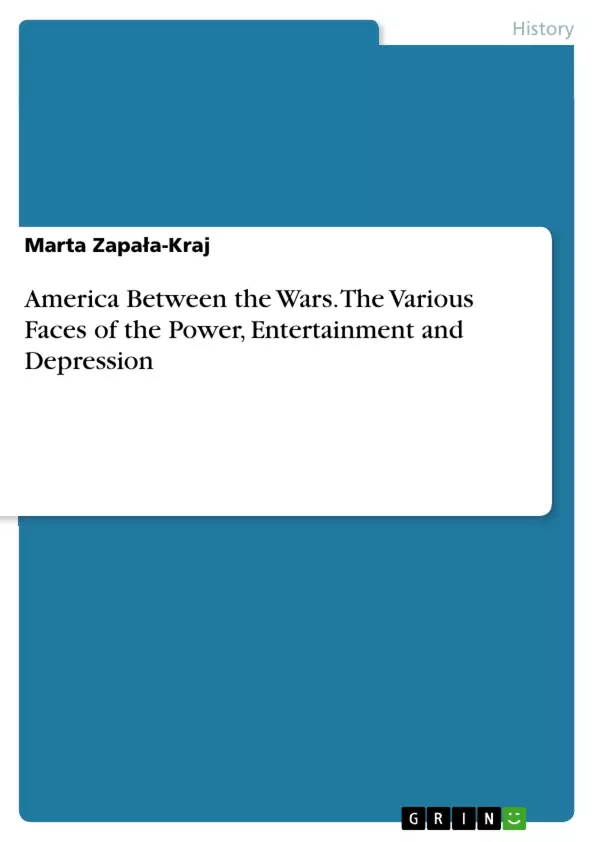The title of my book: America between Wars allowed me to present the most powerful country of the world from a different perspective.
In the aftermath of World War I, the “Great War,” the nations of the world tended to retreat inside themselves, to lick their wounds and reorganize their economic and social structures. The United States, relatively untouched by the first world war, at least in comparison with the losses suffered by the European nations, also turned inward.
In America, the Roaring Twenties were a time of great excitement - bathtub gin, speakeasies, new dress styles, a revolution in manners and morals, the Harlem Renaissance, a golden age of sports, radios, movies, and a booming stock market. There were bad things too, the lawlessness generated by prohibition, the reactivation of the Ku Klux Klan, animosity between country and city, and a resurgence xenophobia that saw the United States slam its doors to most foreign immigration.
Toward the end of the decade came the great stock market crash which, although it was not the cause of the Depression, helped trigger a series of events that led to the worst economic slump in American history. Unemployment sky-jumped, production broke down, banks failed, farmers discovered that it cost more to produce food then they could sell it for, and suicides rose alarmingly.
Into such milieu came Franklin Delano Roosevelt, fifth cousin of progressive President Theodore Roosevelt, and a man who had suffered a serious personal tragedy when he contracted polio. He overcame his disease and was elected twice as governor of New York and came to Washington in 1933 ready to do battle with the forces of depression. Roosevelt’s New Deal was a huge experiment in government intervention in the economy, and although they did not end the Depression, Roosevelt’s policies gave hope to many and changed the relationship between the government and the people forever.
As the country struggled to pull itself out of the Depression, storm Clouds gathered, as missed militarists in Japan and fascist dictators in Germany and Mussolini once again set the world on a collision course with bloody war. Breaking out in 1937 in China in 1939 in Poland, the war eventually drag the United States and as the democracies struggled to maintain a free world. Victorious in the second world war, the United States emerged as the world’s superpower, its first atomic power, and a nation of unprecedented economic might.
Inhaltsverzeichnis (Table of Contents)
- Introduction
- Chapter One The Roaring Twenties - Morally Abandoned
- 1.1. Economic Progress
- 1.2. The Culture of the Twenties
- Chapter Two Prohibition and Ku Klux Klan – the Diseases of America
- 2.1. Politics behind the Prohibition
- 2.2 Mr. Al Capone
- 2.3 Ku Klux Klan and Anti-Catholicism
- Chapter Three The Great Depression and the Presidents of Hard Times
- 3.1 The Great Depression
- 3.2 Herbert Clark Hoover (1874-1964)
- 3.3. Franklin Delano Roosevelt (1882 – 1945)
- 3.4. The 1936 Elections
- 3.5. New Deal and Foreign Policy
- 3.6. The American Preparations for World War II
- 3.7. Franklin Delano Roosevelt and His Presidency in Retrospect
Zielsetzung und Themenschwerpunkte (Objectives and Key Themes)
The project, "America Between Wars," aims to provide an alternative perspective on the most powerful country in the world during the period between 1919 and 1941. This period was marked by both prosperity and decline, and the project will delve into the social, cultural, economic, and political changes that shaped the United States during this time.
- The Roaring Twenties and their impact on American society.
- The rise of organized crime during the Prohibition era.
- The Great Depression and its impact on the American economy and society.
- The role of President Franklin Delano Roosevelt and the New Deal in responding to the Depression.
- The political and social climate of the 1930s and the rise of fascism and militarism abroad.
Zusammenfassung der Kapitel (Chapter Summaries)
Chapter One, "The Roaring Twenties – Morally Abandoned," examines the social and economic dynamics of the 1920s in the United States. It explores the rise of consumerism, the impact of the automobile industry, and the cultural changes that took place, such as the rise of jazz music, the "flapper" movement, and the increasing acceptance of women in the workforce.
Chapter Two, "Prohibition and Ku Klux Klan – the Diseases of America," delves into two major social issues of the 1920s. The first section analyzes the political motivations behind the Prohibition Act and its consequences, including the rise of organized crime and figures like Al Capone. The second section explores the resurgence of the Ku Klux Klan and its anti-immigrant and anti-Catholic sentiments.
Chapter Three, "The Great Depression and the Presidents of Hard Times," examines the economic crisis that engulfed the United States in the 1930s. This chapter discusses the causes of the Great Depression, the policies implemented by President Herbert Hoover, and the eventual rise of President Franklin Delano Roosevelt. The chapter also explores the impact of the Depression on the American people and the emergence of the New Deal, a series of programs designed to address the economic crisis and restore hope to the nation.
Schlüsselwörter (Keywords)
Key terms and concepts explored in this project include: Roaring Twenties, Prohibition, organized crime, Ku Klux Klan, xenophobia, Great Depression, New Deal, Franklin Delano Roosevelt, Herbert Hoover, World War II, and American society in the 1920s and 1930s. This project aims to provide an in-depth analysis of these key aspects of American history, highlighting the complexities and contradictions of this transformative period.
- Quote paper
- Marta Zapała-Kraj (Author), 2018, America Between the Wars. The Various Faces of the Power, Entertainment and Depression, Munich, GRIN Verlag, https://www.grin.com/document/470999



